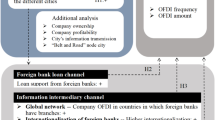Abstract
Japanese manufacturing small and medium enterprises (SMEs) have actively undertaken Foreign Direct Investment (FDI) in Asia since the mid-1980s. FDI contributes to economic growth of the FDI recipient countries, as it brings in not only financial resources for investment but also technologies and managerial know-how, which are important factors for promoting economic growth. Recognizing these benefits of receiving FDI, policy makers in developing countries have formulated various strategies to attract FDI. This paper examines the factors in the host countries that would attract FDI by Japanese SMEs. Our results show the importance of both supply-side and demand-side factors in the recipient countries for attracting FDI by Japanese SMEs. Supply-side factors include abundance of low-wage labor, availability of well-developed infrastructure, and good governance of the host government, while an important demand-side factor is the presence of sizable local market. In addition, Japanese SMEs regard industrial agglomeration, which has a element of both supply and demand factors, as an important factors making FDI decision. Supply-side factors are found to be important for attracting Japanese FDI in developing countries, while demand-factors play a role in attracting Japanese FDI in developed countries. A comparison of the results for SMEs to those for large firms reveals that SMEs are more sensitive to the conditions in the host countries in making their FDI decision. In particular, SMEs regard the availability of low-wage labor, well-developed infrastructure, and industrial agglomeration as important elements much more than large firms. High sensitivity of SMEs to local economic conditions in their decision on FDI location may be explained by their limited availability of financial and human resources and high dependence on overseas production in their business. In light of these findings, we conclude that countries interested in hosting FDI have to provide a very attractive business environment.
Similar content being viewed by others
References
Cushman, David O., 1988, ‘U.S. Bilateral Trade Flows and Exchange Risk during the Floating Period’, Journal of International Economics 24(3/4), 317–330.
Export-Import Bank of Japan, 1996, EXIM Review, volume 16, number 1.
Fujita, Masataka, 1995a, ‘Small and Medium-Sized Transnational Corporations: Trends and Patterns of Foreign Direct Investment’, Small Business Economics 7(3), 183–204.
Fujita, Masataka, 1995b, ‘Small and Medium-Sized Transnational Corporations: Salient Features’, Small Business Economics 7(4), 251–271.
Fukao, Kyoji and Ximing Yue, 1997, ‘Denki Meka no Ricchi Sentaku [The Locational Selection of Japanese Electronics Firms]’, Mita Gakkai Zasshi [Mita Journal of Economics] 90(2), 11–39 [in Japanese].
Fukao, Kyoji and Hoon Chung, 1996, ‘Chokusetsu Toshi Aitekoku no Kettei Yoin: Wagakuni Seizogyo ni Kansuru Jissho Bunseki [The Determinants of FDI Recipients: An Analysis of Japanese Manufacturing Industry]’, Financial Review 38 1–31 [in Japanese].
Head, Keith, John Reis and Deborah Swenson, 1995, ‘Agglomeration Benefit and Location Choice: Evidence from Japanese Manufacturing Investments in the United States’, Journal of International Economics 38, 199–222.
Knack, Stephen and Philip Keefer, 1995, ‘Institutions and Economic Performance: Cross-Country Tests Using Alternative Institutional Measures’, Economics and Politics 7(3), 207–227.
McFadden, Daniel, 1974, ‘Conditional Logit Analysis of Qualitative Choice Behavior’, in P. Zaremka (ed.), Frontiers in Econometrics, New York: Academic Press.
Okamoto, Yumiko and Shujiro Urata, 1997, ‘Japan's Foreign Direct Investment in Malaysia in the 1990s’, in K. Sugiyama and S. Leong (eds.), Revitalization of Japan's Economy: Implications for Malaysia, Malaysia: Institute of Strategic and International Studies (ISIS).
Thursby, Jerry G. and Marie C. Thursby, 1987, ‘Bilateral Trade Flows, the Linder Hypothesis, and Exchange Risk’, Review of Economics and Statistics 60(3), 488–405.
Tokunaga, Suminori and Ryoichi Ishi, 1995, ‘Nihon Kigyo no Gurobaru oyobi Higashi Ajia niokeru Chokusetsu Toshi Kettei ni Kansuru Keiryo Bunseki: Kondisshonaru Logit Moderu niyoru Takokuseki Kigyo no Ricchi Sentaku Bunseki [An Econometric Analysis of the Determinants of Japanese FDI in the World and in East Asia: An Application of the Conditional Logit Model to the Locational Choice of Multinational Enterprises]’, in K. Ohno and Y. Okamoto (eds.), EC, NAFTA, Higashi Ajia to Gaikoku Chokusetsu Toshi: Tojo Kokueno Eikyo, Tokyo: The Institute of Developing Economies [in Japanese].
Urata, Shujiro, 1993, ‘Obstacles to Further Economic Growth in East Asia and Japan's Economic Assistance’, Japan Review of International Affairs 7(4), 297–315.
Urata, Shujiro and Hiroki Kawai, 1997, ‘Governance and the Flow of Japanese Foreign Direct Investment’, presented at a World Bank Workshop on Governance and Private Investment in East Asia, Hakone, Japan.
Wakasugi, Ryuhei, 1997, ‘Nihon Kigyo no Chokusetsu Toshi: Shijo Yoin to Kigyo Tokushuteki Yoin no Jissho Bunseki [FDI by Japanese Firms: An Empirical Investigation of Market Characteristics and Firm-Specific Characteristics]’, Mita Gakkai Zasshi [Mita Journal of Economics] 90(2), 40–58 [in Japanese].
Wheeler, David and Ashoka Mody, 1992, ‘International Investment Location Decisions: The Case of U.S. Firms’, Journal of International Economics 33, 57–76.
Woodward, Douglas P., 1992, ‘Locational Determinants of Japanese Manufacturing Startups in the United States’, Southern Economic Journal 58 (January), 690–708.
Author information
Authors and Affiliations
Rights and permissions
About this article
Cite this article
Urata, S., Kawai, H. The Determinants of the Location of Foreign Direct Investment by Japanese Small and Medium-sized Enterprises. Small Business Economics 15, 79–103 (2000). https://doi.org/10.1023/A:1008173912813
Issue Date:
DOI: https://doi.org/10.1023/A:1008173912813




